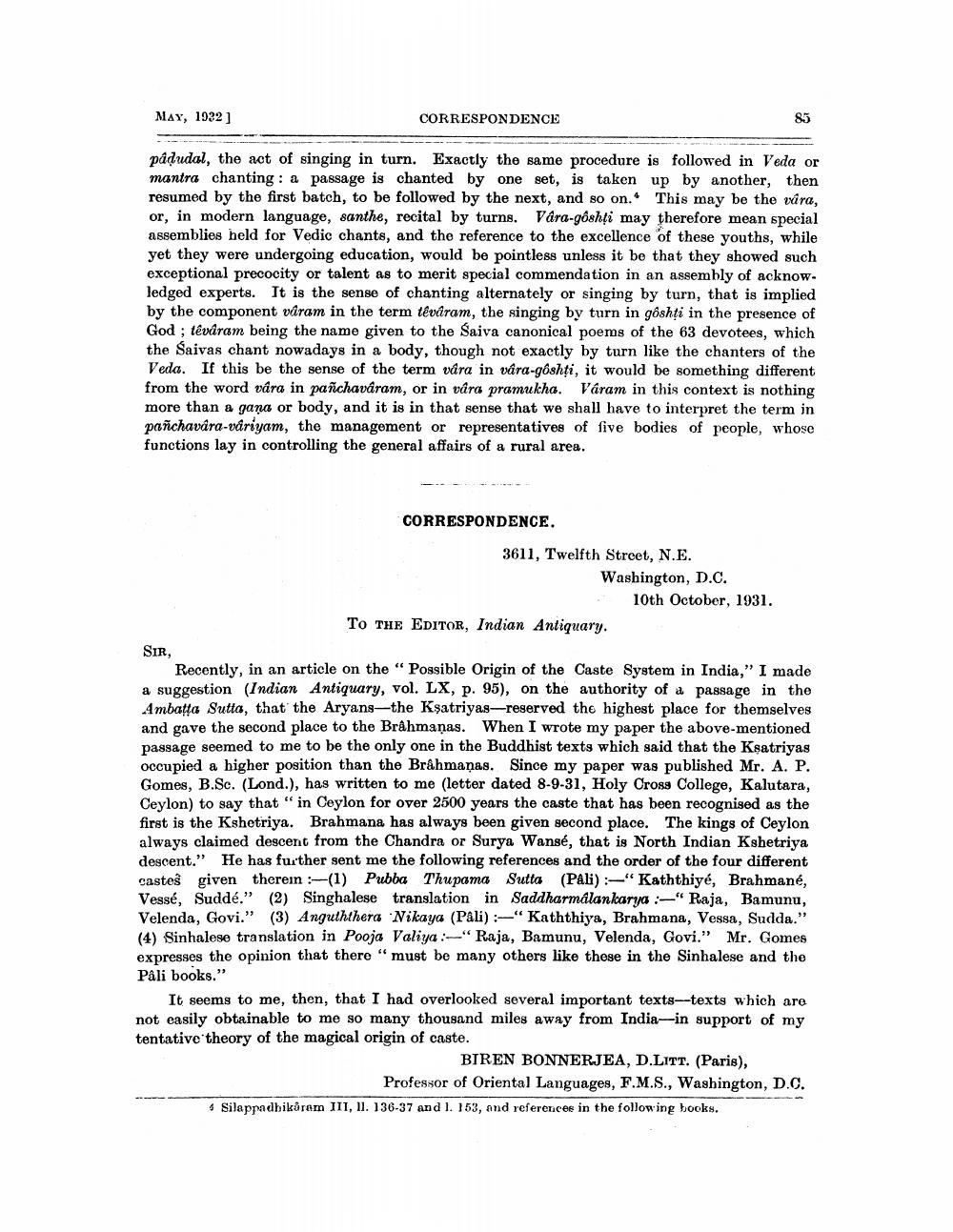________________
MAY, 1932]
CORRESPONDENCE
85
pådudal, the act of singing in turn. Exactly the same procedure is followed in Veda or mantra chanting: a passage is chanted by one set, is taken up by another, then resumed by the first batch, to be followed by the next, and so on. This may be the vära, or, in modern language, santhe, recital by turns. Vara-gôshți may therefore mean special assemblies held for Vedic chants, and the reference to the excellence of these youths, while yet they were undergoing education, would be pointless unless it be that they showed such exceptional precocity or talent as to merit special commendation in an assembly of acknow. ledged experts. It is the sense of chanting alternately or singing by turn, that is implied by the component váram in the term têváram, the singing by turn in gôshți in the presence of God ; têváram being the name given to the Saiva canonical poems of the 63 devotees, which the Saivas chant nowadays in a body, though not exactly by turn like the chanters of the Veda. If this be the sense of the term våra in våra-gôshti, it would be something different from the word vara in panchaváram, or in våra pramukha. Varam in this context is nothing more than a gana or body, and it is in that sense that we shall have to interpret the term in pañchavara-váriyam, the management or representatives of five bodies of people, whose functions lay in controlling the general affairs of a rural area.
CORRESPONDENCE.
3611, Twelfth Street, N.E.
Washington, D.C.
10th October, 1931. TO THE EDITOR, Indian Antiquary.
SIR,
Recently, in an article on the "Possible Origin of the Caste System in India," I made a suggestion (Indian Antiquary, vol. LX, p. 95), on the authority of a passage in the Ambatta Sutta, that the Aryans—the Kşatriyas-reserved the highest place for themselves and gave the second place to the Brâhmaņas. When I wrote my paper the above-mentioned passage seemed to me to be the only one in the Buddhist texts which said that the Ksatrivas Occupied a higher position than the Brahmaņas. Since my paper was published Mr. A. P. Gomes, B.Sc. (Lond.), has written to me (letter dated 8-9-31, Holy Cross College, Kalutara, Ceylon) to say that "in Ceylon for over 2500 years the caste that has been recognised as the first is the Kshetriya. Brahmana has always been given second place. The kings of Ceylon always claimed descent from the Chandra or Surya Wansé, that is North Indian Kshetriya descent." He has further sent me the following references and the order of the four different castes given therein (1) Pubba Thupama Sutta (Pali) "Kaththiyé, Brahmané, Vessé. Suddé." (2) Singhalese translation in Saddharmálankarna :-"Raja, Bamunu. Velenda, Govi." (3) Anguththera Nikaya (Pali) "Kaththiya, Brahmana, Vessa, Sudda." (4) Sinhalese translation in Pooja Valiya :-"Raja, Bamunu, Velenda, Govi." Mr. Gomes expresses the opinion that there "must be many others like these in the Sinhalese and the Pali books."
It seems to me, then, that I had overlooked several important texts--texts which are not easily obtainable to me so many thousand miles away from India-in support of my tentative theory of the magical origin of caste.
BIREN BONNERJEA, D.LITT. (Paris),
Professor of Oriental Languages, F.M.S., Washington, D.C. Silapradhikaram III, II. 136-37 and I. 153, and references in the following books.




